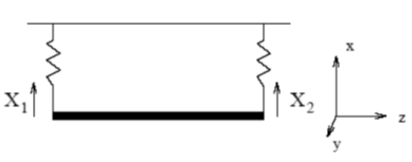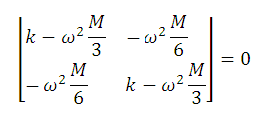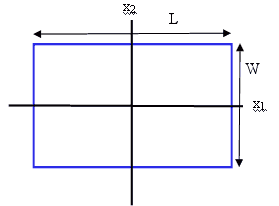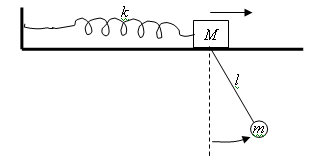
A rigid uniform bar of mass M and length L is supported in equilibrium in a horizontal position by two massless springs attached at each end. The identical springs have spring constant k. The motion of the center of mass is constrained to move parallel to the vertical x-axis. Furthermore, the motion of the bar is constrained to lie in the xz plane. Let x1 and x2 be the departures of the two ends from their equilibrium positions, as shown.

(a) Show that the moment of inertia for a bar about
the y-axis through its center of mass is ML2/12.
(b) Construct the Lagrangian for the bar-spring arrangement assuming only
small deviations from equilibrium.
(c) Calculate the vibrational frequencies of the normal modes for small
amplitude oscillations.
(d) Describe the normal modes of oscillations.
Solution:

ω2 = 4k/M ± 2k/M,
ω- = (2k/M)½,
ω+ = (6k/M)½.
(d) The normal mode
corresponding to ω- has the bar moving up and down while
remaining horizontal. That corresponding to ω+ has the center of mass
of the bar remain stationary while the two ends oscillate up and down exactly
out of phase.
A uniform horizontal rectangular plate (mass M, length L, width
W) rests with its corners on four similar vertical springs with spring
constant k. Find the normal modes of vibration and prove that their
frequencies are in the ratio
1 : √3 : √3.
Solution:

Phonons are quantized lattice vibrations, and many aspects of these
excitations can be understood in terms of simple mode counting.
(a)
Estimate the number of phonon modes in 1 cm3 of a crystalline
material with an inter-atomic spacing of 2 Angstrom.
(b) Assuming that
in thermal equilibrium each phonon mode has kBT of energy, give a
numerical estimate of the heat capacity ΔE/ΔT of this 1 cm3 of
material, in [J/K].
Solution:
A naive model of a solid is that of a bunch of balls (atoms) connected by springs (bound by inter-atomic potentials which can be approximated by harmonic potentials near equilibrium). If each inter-atomic spring has spring constant k, you can relate this microscopic value to the macroscopically measurable value of Young's modulus, Y. Young's modulus is the ratio of stress (F/A, or applied force, F, perpendicular to the cross-sectional area, A, of a bar of material per unit cross-sectional area), to strain (ΔL/L, or the fractional change in length of the bar of material); thus, Y = (F/A)/(ΔL/L). Evaluate k for the inter-atomic springs of aluminum, which has a Young's modulus of 70 GPa. Assume that the aluminum atoms are arranged in a simple cubic lattice (they are really face-centered cubic); you can determine the inter-atomic spacing by knowing that the density of aluminum is 2.70 g/cm3 and that a mole of aluminum has a mass of 27 g. Express your result for k in SI units.
Solution:
A pendulum consisting of a mass m and a weightless string of length l is
mounted on a mass M, which in turn slides on a support without friction and is
attached to a horizontal spring with force constant k, as seen in the diagram.
There is a slot in the support in order that the pendulum may swing freely.
(a) Set up Lagrange's equations.
(b) Find the normal mode
frequencies for small oscillations.
What are those frequencies to
zeroth order in m/M, when m << M?

Solution:
(b) Assume X
and θ are small quantities, and in the equations of motion keep only terms
to first order in small quantities. Then we have, using sinθ ~ θ, cosθ
~ 1.
1st equation: (M + m)d2X/dt2 + mℓd2θ/dt2
= -kX.
2nd equation: d2θ/dt2 + (1/ℓ)d2X/dt2
= -(g/ℓ)θ.
We obtain the same equations if we make the small
displacements approximation earlier and keep only terms up to second order
in the Lagrangian.
Try solutions X = Aexp(iωt), θ = (B/ℓ)exp(iωt),
then
-ω2(M + m)A - ω2mB = -kA, -ω2B
- ω2A = -(g/ℓ)B.
We solve this system of equations by setting

ω4 - ω2(k/M + (g/ℓ)(1 + m/M)) + kg/(ℓM) = 0.
ω2
= (k/M + (g/ℓ)(1 + m/M))/2 ± ½((k/M + (g/ℓ)(1 + m/M))2 -
4kg/(ℓM))½.
ω+2 = (k/M + (g/ℓ)(1 +
m/M))/2 + ½((k/M + (g/ℓ)(1 + m/M))2 - 4kg/(ℓM))½.
ω-2
= (k/M + (g/ℓ)(1 + m/M))/2 - ½((k/M + (g/ℓ)(1 + m/M))2 -
4kg/(ℓM))½.
The frequencies for small oscillations are ω+
and ω-.
[For the relative displacements we have B = Aω2/((g/l)
- ω2). ω+2 > g/l, so A and B
have opposite signs for this mode.]
As m --> 0, ω+ -->
(k/M)½, ω- = (g/ℓ)½. The modes
effectively decouple. The small mass m does no longer influence the
motion of the big mass M. When M oscillates with frequency (k/M)½,
m becomes a driven harmonic oscillator without damping (for small oscillations).
The most general solution is a superposition of oscillations with the driving
frequency and oscillations with the natural frequency of the oscillator.